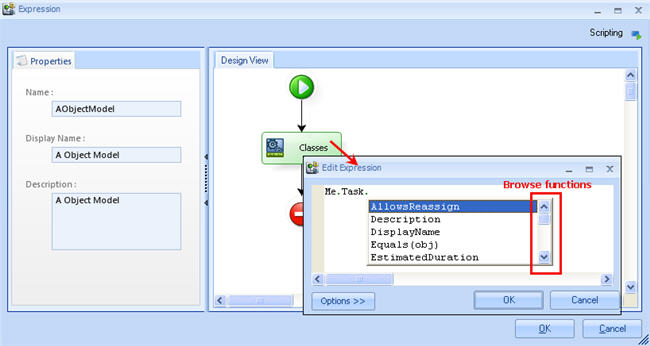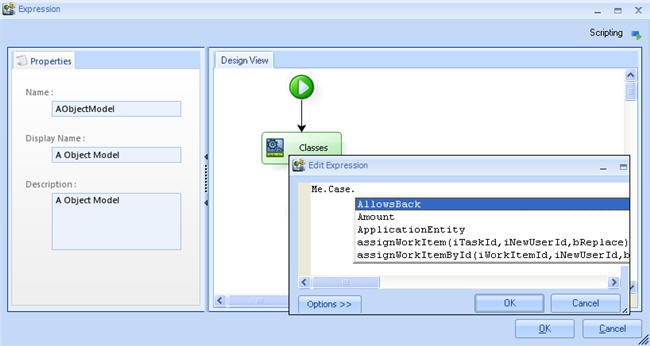Advanced Function: Me
From Business Process Management, BPM and Workflow Automation Wiki | BizAgi BPMS
<keywords content="keywords"> hierarchy, case information, activity information, user information </keywords>
Contents |
Advanced Function: Me
This class obtains information and executes commands on the current state of the process.
The following table contains the detailed description with the characteristics and functions available:
| Property | Sintax | Description |
|
addRelation |
Me.addRelation(xpathRelation) |
Adds an element (a new record) to a collection (one-to-many relationship). |
|
Assignees |
Depends on the subfunction. |
Evaluates the assignees (users) for the current activity. It has subfunctions. |
|
Case |
Depends on the subfunction. |
Evaluates the information related to the current case. It has subfunctions. [[Advanced Function: Me#case_object|]]Examples and further explanation |
|
Context |
Depends on the subfunction. |
Used when the entity evaluated is not the Application Entity. It has the same functions as 'Me.' |
|
Duration |
No parameters |
Evaluates (gets or sets ) the current activity's duration in minutes. |
|
EntryDate |
Depends on the subfunction. |
Evaluates (gets and can manipulate) the current activity's creation date. It has sub functions. |
|
EstimatedSolutionDate |
Depends on the subfunction |
Evaluates (gets and can manipulate) the current activiy's solution date. It has sub functions.
Example |
|
getXpath |
Me.getXPath(xpath) |
Gets the value of an attribute or collection, using xpath expressions that have variables in them. |
|
Id |
Depends on the sub function |
It is the current activity identifier. It is an internal number and should not me manipulated. It has sub functions |
|
removeRelation |
Me.removeRelation(xpathRelation,deleteEntity) |
Removes an element (or record) from a collection (one-to-many relationship). |
|
setXPath |
Me.setXPath(xpath, value) |
Sets the value of an attribute or collection, using Xpath expressions that have variables in them. |
|
Task |
Depends on the sub function |
Evaluates the information related to the current activity |
|
WorkItemState |
Depends on the sub function |
it is the actual state of the current activity; the values for this property can be inactive, suspended, active, completed, not assigned, assigned, aborted, roll backed. |
Me.Task
The information related to the activity can be acceded from here, such as description, display name, activity estimated duration and a set of properties related to the activity.
Some of the functions available are listed below:
|
Property |
Description |
|
Description |
Returns a string with the description the present Task. |
|
DisplayName |
Returns a string with the display name for the actual Task. |
|
EstimatedDuration |
Returns an integer with the estimated duration for the current task with the display name for the actual task. |
|
FunctionalArea |
Gives Access to the Functional Object Area for the current task. |
|
HelpText |
Returns a string with the help text for the current task. |
|
Id |
Current task identifier. |
|
Name |
Current task name. |
|
Phase |
Gives Access to the Phase Object for the current task. |
|
SendNotification |
Indicates if the current task is notification enabled. |
|
TaskType |
Returns the current shape type. |
Me.Assignees
The information related to the users assigned to the current activity can be accessed from this function, such as the positions or job title, role, among others characteristics.
The function returns an array of users, because an activity can be assigned to more than one person. To access the information of a user it is necessary to specify the index in brackets:
Me.Assignees[ ].Email or
Me.Assignees[ ].Domain
Some of the available methods are listed as follows:
|
Property |
Description |
|
Area |
Its an object representing the user area. |
|
BossId |
User id of user boss. |
|
Domain |
String with the user domain. |
|
|
String with the user email. |
|
Enabled |
Indicates whether the User is enabled or not. |
|
EnabledForAssignation |
Indicates whether the User accepts assignations (work item assignations). |
|
FullName |
String with the user full name. |
|
Id |
The user internal Bizagi identification. |
|
Location |
Its an object representing the user location. |
|
Position |
Its an object representing the user position. |
|
Positions |
Collection of positions for the current user. |
|
Roles |
Collection of roles for the current user. |
|
Skills |
Collection of skills for the current user. |
|
UserName |
String with the system user name (for example domain user name). |
|
UserPreferences |
Its an object representing the user preferences. |
|
getUserProperties( ) |
Returns current user properties. |
|
getUserPropertyValue (Bizagi.Organization.CUserPropertyupMetadata ,Bizagi.EntityManager.CEntityentUsrPropVals ) |
Get user property value from specified WFUSER entity instance given a user property upMetadata and the entity for property values entUsrPropVals, which returns a CFact object if the property is a Fact or a CEntity object. |
|
getUserPropertyValue (Bizagi.Organization.CUserPropertyupMetadata ) |
Get user property value from specified WFUSER entity instance given a user property upMetadata, it returns CFact object if property is a Fact or CEntity object. |
|
getUserWFClassAccess( ) |
Returns a data table with the USERWFCLASSACCESSCACHE table entries for the current userl. |
The information related to the case can be accessed from this object such as obtaining the case number, application number, case creator or current user, among others options.
Me.Case.WorkingCredential contains characteristics associated to the user assigned to the current activity, such as working time schema, organization and time zone, among others.
Some of the available objects are listed as follows:
|
Property |
Description |
|
CreationDate |
Case date creation. |
|
Creator |
Case creator |
|
CurrentWorkItems |
A collection of the active Work Items for the current process case. |
|
Id |
Case identifier in the application entity. |
|
ParentProcessId |
It returns or sets the parent process id for the current process case. |
|
ParentTaskId |
It returns the parent process idTask for the current process case. |
|
Priority |
Actual priority for the current work item, it could be (High, Low, Normal). |
|
ProcessDefinition |
Complete process definition for the actual case. Example |
|
ProcessState |
State for the process of the current process case, it could be (Aborted, Completed,Initiated, NotInitiated, Running, Suspended) |
|
Properties |
Object with some important properties about the application for the current process case. |
|
RadicationNumber |
Represents the ticket number that can be associated to one or more instances of a process (cases). This number does not depend on Bizagi and represents a creation number for the business to be modeled. Example |
|
Severity |
Severity for the current process case, it could be (High, Low, Normal) |
|
SolutionDate |
Returns or sets actual solution date for the current process case. |
|
SubProcessType |
If the current case is sub process, it denotes the sub process type. Valid values are: Integrated, none, StandAlone. |
|
WorkingCredential |
Gives an authentication credential for the actual user working in the actual process case. More Info. |
|
assignWorkItem |
Assigns the specified task corresponding to the to the specified user. bReplace indicates whether the current users must be replaced for the new one or if the new user must be just added to the current users. |
|
getChildProcesses |
Returns a collection with all sub processes for the current process case instance. |
|
getCurrentWorkItems |
Returns a collection with all worksites for the current process case. |
|
getWorkItem |
Returns a work item for a given task id. |
|
persistProcess |
Saves all changes to the database for the current process case. |
|
persistProperties |
Saves all task properties and changes to the database for the given work item identifier. |
|
CaseNumber |
Represents the ticket number that can be associated to one or more instances of a process (cases). This number does not depend on Bizagi and represents a creation number for the business to be modeled. Example
|
<comments />




